|
NATURE
Existing since the first days of the museum nature department gives
information on geography of the Khabarovsk Territory, variety of
its mineral resources and diversity of its unique flora and fauna.
It has valuable exhibits - nature monuments collected by its workers,
scientists and naturalists P.T. Bykov, V.K. Arsenyev, N.A. Desulavy,
V.V. Dombrovsky, S.Ya. Sizykh, A.I. Kordakov, G.E. Roslyakov and
many others inquisitive and disinterested helpers.
The relief map of the Russian Far East is placed by
the entrance t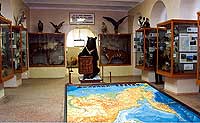 o
the first section. The Khabarovsk Territory is located in the eastern
part of the Euro-Asian continent. Namely its location determines natural
andclimate peculiarities and components of relief in the Territory.
They are mountains, valleys and lowlands, rivers, lakes and seas. o
the first section. The Khabarovsk Territory is located in the eastern
part of the Euro-Asian continent. Namely its location determines natural
andclimate peculiarities and components of relief in the Territory.
They are mountains, valleys and lowlands, rivers, lakes and seas.
Exhibits of the palaeonthological section are the remains
of ancient plants and animals. Th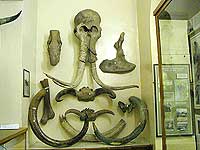 ey
narrate the story of evolution at the border of continent and world
ocean where the sea and land fossils are neighbours. The skull of Chukotka
mammoth is the most noticeable among them. It was presented to the museum
by the governor-general of the Priamursky Territory N.L. Gondatti in
1896. The mammoth tusk of the same age found 8 meters deep in the ground
within the city of Khabarovsk in 1975 testifies to the fact that those
animals inhabited Priamurye 41 thousand years ago. ey
narrate the story of evolution at the border of continent and world
ocean where the sea and land fossils are neighbours. The skull of Chukotka
mammoth is the most noticeable among them. It was presented to the museum
by the governor-general of the Priamursky Territory N.L. Gondatti in
1896. The mammoth tusk of the same age found 8 meters deep in the ground
within the city of Khabarovsk in 1975 testifies to the fact that those
animals inhabited Priamurye 41 thousand years ago.
The unique exhibit of the Khabarovsk Regional Lore
Museum is a full skeleton of 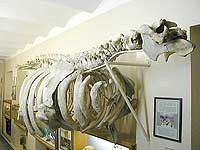 sea
cow of Steller. Russian seamen who took part in the V. Bering expedition
saw it for the first time near the Comandor islands in 1741. That animal
was 10 metres long with the weight of about 4 tons and fed on seaweeds.
After that in about 27 years sea cows were exterminated by hunters for
sea animals. That's why the full skeletons of those animals are rare.
By the order of the Priamursky governor-general S.M. Dukhovskoy two
skeletons were found on the Bering island. They were brought to the
museum in 1897 and in 1898. Later one of them was sold to the Paris
Natural Historical Museum for these funds to finish the building of
the Khabarovsk Regional Lore Museum. sea
cow of Steller. Russian seamen who took part in the V. Bering expedition
saw it for the first time near the Comandor islands in 1741. That animal
was 10 metres long with the weight of about 4 tons and fed on seaweeds.
After that in about 27 years sea cows were exterminated by hunters for
sea animals. That's why the full skeletons of those animals are rare.
By the order of the Priamursky governor-general S.M. Dukhovskoy two
skeletons were found on the Bering island. They were brought to the
museum in 1897 and in 1898. Later one of them was sold to the Paris
Natural Historical Museum for these funds to finish the building of
the Khabarovsk Regional Lore Museum.
The section "Mineral resources" shows great and various
amounts of mineral resources within the area of the Khabarovsk Territory,
such as complex ore deposits, soft and hard coals, precious and
semi-precious stones. The very rare minerals are druses of quartz,
pyrites and other minerals. There is the only meteorite here found
within the Khabarovsk Territory called "Khabarovsk" and
also fragments of the famous Sikhote-Alyn meteorite which fell down
in 1947.
The fauna and flora of the Russian Far East is both
unique and varied. Its originality consists first of all in the wonderful
combination of northern and southern, subtropical and Siberian species
both in the vegetation and animal worlds. There is no other land in
the world where the tiger can hunt for the northern reindeer and lianas
of Amur 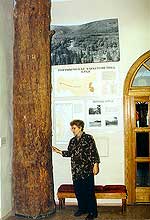 woodland
grape entwine the larch and fir trees. Many ancient species of flora
and fauna survived the Ice Age on this territory. For example, our contemporary
is the yew tree, the relic of the tertiary period, one of the most ancient
conifers on the planet. A 4 metre fragment of the trunk of a 1500 years
old yew tree is exposed in the nature department. Some representatives
of the aralia family- eleutherococcus and "root of life"-ginseng;
from magnolia family-shizandra chinensis; from water-lilies - lotus
of Komarov and many others belong by right to the same category- "living
fossils". woodland
grape entwine the larch and fir trees. Many ancient species of flora
and fauna survived the Ice Age on this territory. For example, our contemporary
is the yew tree, the relic of the tertiary period, one of the most ancient
conifers on the planet. A 4 metre fragment of the trunk of a 1500 years
old yew tree is exposed in the nature department. Some representatives
of the aralia family- eleutherococcus and "root of life"-ginseng;
from magnolia family-shizandra chinensis; from water-lilies - lotus
of Komarov and many others belong by right to the same category- "living
fossils".
Within the area of the Khabarovsk Territory one can
see about 80 mammal species, 380 species of birds, amphibia and reptiles-8
species of each class. Many of them are shown as taxidermed animals
in the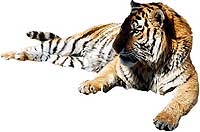 nature department. Among them there are such usual animals in the Territory
as wolf, fox, badger, squirrel, river cormorant, long-tailed tawny owl,
Amur grass-snake, black spotted frog. There are also animals here written
down in the list of rare and extincting species, such as Amur tiger,
red wolf, leopard, Amur wild cat, fish owl, golden eagle, black crane,
scaly goosander, ibis, Far Eastern leatherback turtle.
nature department. Among them there are such usual animals in the Territory
as wolf, fox, badger, squirrel, river cormorant, long-tailed tawny owl,
Amur grass-snake, black spotted frog. There are also animals here written
down in the list of rare and extincting species, such as Amur tiger,
red wolf, leopard, Amur wild cat, fish owl, golden eagle, black crane,
scaly goosander, ibis, Far Eastern leatherback turtle.
The ichthyofauna 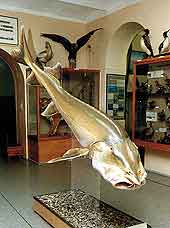 of
the Amur river, the richest in the country, is formed by more than 100
fish species. The most part of marketable fish is represented in the
exposition. A special place is taken by kaluga sturgeon - the biggest
freshwater fish in the world. The stuffed kaluga fish arouses invariable
interest of visitors. It was caught not far away from Khabarovsk in
1996. It weighed 250 kilograms by the length 3,5 metres. Many specialists
did their best to taxiderm that fish. They are Khabarovsk sculptors
E.D. Malovinsky, A.A. Ephimov, taxidermist I.D. Chernyshov, Honoured
Artist of Russia V.P. Drosdov. of
the Amur river, the richest in the country, is formed by more than 100
fish species. The most part of marketable fish is represented in the
exposition. A special place is taken by kaluga sturgeon - the biggest
freshwater fish in the world. The stuffed kaluga fish arouses invariable
interest of visitors. It was caught not far away from Khabarovsk in
1996. It weighed 250 kilograms by the length 3,5 metres. Many specialists
did their best to taxiderm that fish. They are Khabarovsk sculptors
E.D. Malovinsky, A.A. Ephimov, taxidermist I.D. Chernyshov, Honoured
Artist of Russia V.P. Drosdov.
The main natural zones of the Khabarovsk Territory
with their inhabitants are displayed in the second section of the nature
department. The 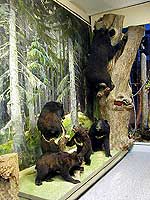 figures
of the biggest mammals of the Far Eastern forest are reconstructed by
the best taxidermists. The diorama "The cedar broad-leafed forest"
makes a big impression on visitors. It was made by the artist V.N. Vysotsky
in 1939-1941 and reconstructed by V.P. Sysoev in 1964-1966. A moment
full of expression is displayed there- the battle of the strongest beasts
of prey in the Far Eastern forest - the brown bear and the Amur tiger.
To the left of the diorama there is the unique exhibit - a real den
of a Himalayan bear in the trunk of the more than 300 years old larch
tree made by the bear at the height of 18 metres. figures
of the biggest mammals of the Far Eastern forest are reconstructed by
the best taxidermists. The diorama "The cedar broad-leafed forest"
makes a big impression on visitors. It was made by the artist V.N. Vysotsky
in 1939-1941 and reconstructed by V.P. Sysoev in 1964-1966. A moment
full of expression is displayed there- the battle of the strongest beasts
of prey in the Far Eastern forest - the brown bear and the Amur tiger.
To the left of the diorama there is the unique exhibit - a real den
of a Himalayan bear in the trunk of the more than 300 years old larch
tree made by the bear at the height of 18 metres.
The diorama "Th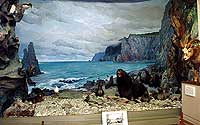 e
coast of the Okhotsk sea" shows an ecosystem extremely full of
life. In the summer months the rocks are the place where a lot of sea
birds nest - guillemots, cormorants, pigeon guillemots and tufted puffins.
On display one can also see breeding-grounds (rookeries) of many aquatic
mammals - sea otters, seals, fur seals. e
coast of the Okhotsk sea" shows an ecosystem extremely full of
life. In the summer months the rocks are the place where a lot of sea
birds nest - guillemots, cormorants, pigeon guillemots and tufted puffins.
On display one can also see breeding-grounds (rookeries) of many aquatic
mammals - sea otters, seals, fur seals.
The exposition of the nature department gives the visitors an opportunity
to penetrate into the wonderful world of the Far Eastern nature
and to find out some of its secrets.
| 




